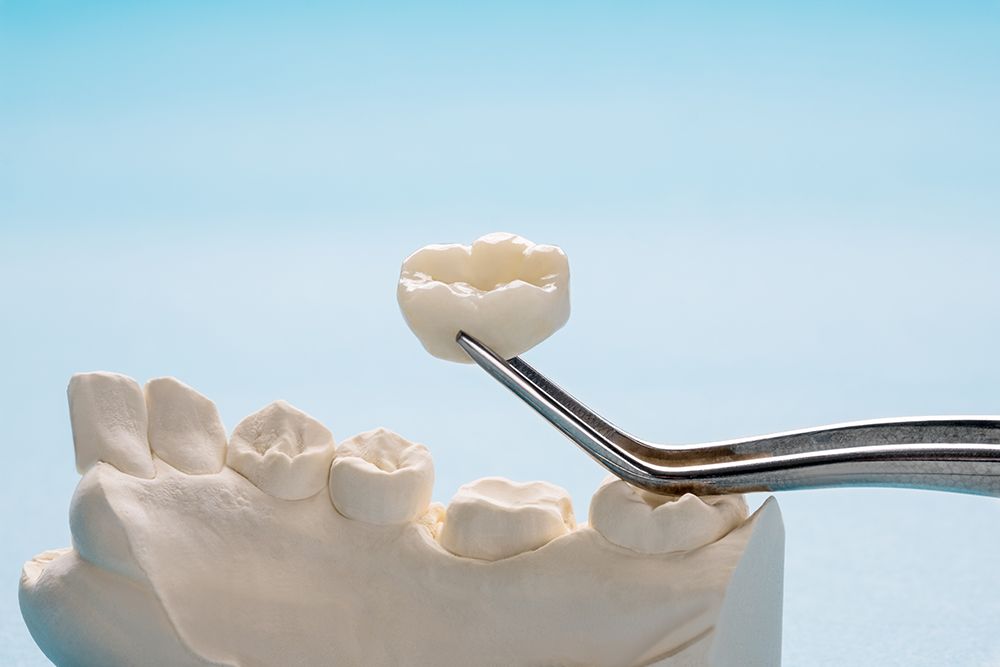Why You Should Bond to Zirconia Instead of Cement
You can do either. So, why should you bond to zirconia instead of cement? We have a few ideas.
SUJIT /STOCK.ADOBE.COM

Among zirconia's many excellent benefits is the ability to cement or bond indirect zirconia restorations. But, of course, that means you must choose. So, why should you choose to bond zirconia? We have a few ideas.
First, it is critical to note that this decision is not an always/never proposition. There will be times when micromechanical retention is all you need and other times when the chemical adhesive is necessary.
For example, Nathaniel Lawson, DMD, PhD, associate professor and director, Division of Biomaterials at the University of Alabama at Birmingham School of Dentistry, says that you should bond to zirconia instead of cement with a conventional cement (i.e., resin-modified glass ionomer) when extra retention is necessary. For example, if you are looking at a short or over-tapered prep, or a non-retentive prep, like what you have with overlays, veneers, and Maryland bridges.
Also, Dr Lawson explains that bonding zirconia can reinforce a restoration that otherwise would have a higher fracture risk. Bonded zirconia can increase the force a restoration can withstand before breaking.
Author and speaker Greg Campbell, DDS, a private-practice dentist in Long Beach, California, says one of the most significant advantages of bonding zirconia over cementation is the additional strength of the restoration. Moreover, you can be more conservative with your reduction.
"Most people I talk to under reduce," Dr Campbell says. "So, one of the great things about zirconia is it's very forgiving to the clinician if you under-reduce."
Dr Campbell explains that the literature has shown if you use a resin-modified glass ionomer, you require a more significant reduction. So, if you use a resin-modified glass ionomer cement, you may have a higher likelihood of fracture. In contrast, you can be more conservative but have more favorable long-term results when you employ adhesion.
"It's just a stronger restoration that has a stronger micro tensile bond strength," Dr Campbell says.
In addition, the tissue responds better to zirconia, Dr Campbell says. Also, in some cases, you can get reattachment, something you don't get with the other indirect materials.
"So, if you are polishing zirconia and bonding it in, you are going to have a good long-term result," Dr Campbell says, adding that isolation is also critical to proper adhesion or cementation.
Kuraray's Guide to Zirconia Bonding Essentials asserts these specific parameters where bonding zirconia restorations with self-adhesive resin cements:1
- Preparation with an adequate cervical occlusal height greater than 3 millimeters
- Preparation with a good taper between 2 to 5 degrees.
When bonding with an adhesive resin cement or an esthetic resin cement, they recommend:2
- A tooth with a short clinical crown, less than 3 millimeters
- A tooth with an over-tapered preparation greater than 5 degrees
BISCO's eBook, The Dos and Don'ts of Bonding Zirconia, also indicates where bonding zirconia is preferable to luting. In addition to preparations with insufficient retention, resin cement is preferable to RMGI cement when using high translucency zirconia or zirconia restorations with a minimal occlusal thickness. Resin cement can handle stress load distribution better than RMGI cement, protect against crack formation, and optimize overall restorative strength. There is no replacement for the durable and predictable bond possible with a separately placed bonding agent inherent in resin cement.3
Bonding to Zirconia Works, or So the Literature Says
The literature also supports bonding to zirconia. A meta-analysis in The Journal of Dental Research found that treating zirconia's surface with airborne particle abrasion with 50 μm Al2O3 particles and application of 10-methacryloly decyl dihydrogen phosphate (10-MDP) primer will allow a bond.4
Another study published earlier this year in the Journal of Dental Sciences suggests that pretreating the surface of highly translucent zirconia with sandblasting and a bonding agent, which was then bonded with primer-treated dentin by using resin cement, provided excellent strength and durability over time. Without treatment of the zirconia and dentin surfaces, the bond strength of self-adhesive resin cement to highly translucent zirconia would be pretty low. However, the surface pretreatments enhanced the bond strength of resin adhesives. Therefore, the researchers suggest that clinicians employ proper mechanical treatment and chemical bond between the restoration and dentin using a surface treatment.5
However, universal adhesives also create strong bonds with zirconia. The Journal of Clinical and Experimental Dentistry found that universal adhesives, Futura Bond U (VOCO America) and Clearfil Universal Bond (Kuraray), both provided excellent bond strength to zirconia.6
The researchers felt the addition of 10-MDP (10-methacryloyloxydecyl dihydrogen phosphate) significantly contributed to this bond's success. The chemistry between 10-MDP phosphate groups and the hydroxyl group found on the surface of zirconia creates a chemical bond. Therefore, the researchers found that these universals could be an alternative to using a specific primer for different substrates. Moreover, adhesives have a chemical composition that contains hydrophilic and functional agents that form a durable and hydrophobic tooth and restorative interface after polymerization.7
Zirconia Had an Early Reputation for Luting, Not Bonding
Despite all this evidence and countless articles and presentations to the contrary, there exists a rumor that you cannot bond to zirconia or that you can, but it will not be as strong a bond as you would get from other materials. The persistence of this rumor baffles some clinicians that are confident in the ability to bond to zirconia.
Dr Lawson thinks the reason for this rumor or distrust of bonding zirconia is that bonding to zirconia follows different steps than bonding to other materials like lithium disilicate. First, lithium disilicate can be etched, and clinicians can visualize how that looks. Also, lithium disilicate contains glass, Dr Lawson explains. Therefore, clinicians are comfortable chemically bonding to glass with silane. Bonded lithium disilicate and porcelain have been around for a long time and allowed clinicians to develop a trust in this bond.
However, since zirconia does not contain glass, it cannot be etched the same way to create micromechanical links to the cement. Instead, he says that zirconia requires sandblasting with alumina particles to achieve surface roughness. So, bonding to zirconia requires learning a new system and building up trust that it will produce a suitable bond, which can prove to be a stumbling block for clinicians that have enjoyed success for years bonding to glass ceramics. Dr Lawson says it is hard to imagine sandblasting can produce as good surface texture as etching.
"So, that's why you need to visualize the surface texture of sandblasted zirconia under a microscope and conduct bond testing research," Dr Lawson explains. "If you look at bond strength testing research, you will see that bonding to zirconia is possible."
Dr Campbell thinks that part of persistence involves technique failures. For example, many clinicians implemented bonding techniques they have always used in adhesive dentistry. When those techniques failed, clinicians assumed the problem is the zirconia. However, the problem was not knowing the differences in the approach required for bonding with zirconia.
"There is a technique, and bonding to zirconia is technique sensitive, but it's straightforward," Dr Campbell explains. "But it's not easy if you don't know how to do it right."
So, How Do You Bond the Right Way to Zirconia?
First, Dr Campbell agrees it is essential to air abrade or micro-etch the intaglio surface of the restoration with a sandblaster. The pressure should be 2 bars, which translates to 18 to 32 psi with 50-micron aluminum oxide particles. Without that micro-etch, you will have a failure, he says.
Next, it is essential to ensure you do not contaminate the intaglio surface. Unlike other materials, phosphates on the surface of zirconia will interfere with the bond. However, because they all decrease the bond strength, you can't use the usual decontaminators, like rinsing, phosphoric acid, or bleach. Instead, Dr Campbell recommends a zirconia cleaner like ZirClean® cleaning gel (BISCO), IvoClean (Ivoclar), or KATANA™ Cleaner (Kuraray).
"I like the Kuraray Cleaner because you can use it in the mouth, on the tooth, and inside the restoration," Dr Campbell says.
The next critical element to bonding with zirconia is using a product with the phosphate monomer MDP (10-Methacryloyloxydecyl dihydrogen phosphate). However, Dr Campbell says that all MDP products are not the same. You need a catalyst that enables the MDP to do its job and cure properly.
Dr Campbell says that Kuraray still has the catalyst patent, which is the gold standard for bonding and is what separates them from the competitors. He prefers PANAVIA™ SA Cement Universal for bonding his zirconia restorations because it cleans up well, and he trusts that the restoration will not come off.
"The catalyst that Kuraray has makes this the superior product," Dr Campbell says. "So, using the right tool for the right job and in the right order is very important."
References
1. Powers, J.M. and O'Keefe, K.L. (no date) Dental Products Online: Dental Lab Materials, Kuraray Dental. Kuraray America, Incl. Available at: https://kuraraydental.com/ (Accessed: November 8, 2022).
2. Powers, J.M. and O'Keefe, K.L. (no date) Dental Products Online: Dental Lab Materials, Kuraray Dental. Kuraray America, Incl. Available at: https://kuraraydental.com/ (Accessed: November 8, 2022).
3. The DOS and don’ts of bonding zirconia - bisco.com (no date) Www.bisco.com. Dental Products Report. Available at: https://www.bisco.com/assets/1/7/Dos_and_Donts_of_Bonding_Zirconia.pdf (Accessed: November 8, 2022).
4. Inokoshi M, De Munck J, Minakuchi S, Van Meerbeek B. Meta-analysis of bonding effectiveness to zirconia ceramics. J Dent Res. 2014 Apr;93(4):329-34. doi: 10.1177/0022034514524228. Epub 2014 Feb 21. PMID: 24563487.
5. Liu J, Yang C, Luo J, Liu Y, Yan M, Ding S.,Bond strength of self-adhesive resin cements to a high transparency zirconia crown and dentin,Journal of Dental Sciences, 2022; 17 (2): https://doi.org/10.1016/j.jds.2021.12.008
6. Zakavi F, Mombeini M, Dibazar S, Gholizadeh S. Evaluation of shear bond strength of zirconia to composite resin using different adhesive systems. J Clin Exp Dent. 2019;11(3):e257-e263. Published 2019 Mar 1. doi:10.4317/jced.55428
7. Zakavi F, Mombeini M, Dibazar S, Gholizadeh S. Evaluation of shear bond strength of zirconia to composite resin using different adhesive systems. J Clin Exp Dent. 2019;11(3):e257-e263. Published 2019 Mar 1. doi:10.4317/jced.55428
ACTIVA BioACTIVE Bulk Flow Marks Pulpdent’s First Major Product Release in 4 Years
December 12th 2024Next-generation bulk-fill dental restorative raises the standard of care for bulk-fill procedures by providing natural remineralization support, while also overcoming current bulk-fill limitations.
















